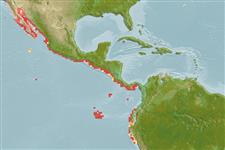Environment: milieu / climate zone / depth range / distribution range
पारिस्थितिकी
समुद्री; खारा ड़िमरसल; गहराई सीमा 0 - 60 m (Ref. 9342). Subtropical; 34°N - 9°S, 118°W - 79°W (Ref. 5222)
Eastern Central Pacific: San Francisco Bay, California, USA to Peru and the Galapagos Islands.
आकार / वज़न / Age
Maturity: Lm ? range ? - ? cm
Max length : 150 cm TL पुल्लिंग / अलिंग; (Ref. 5222); अधिकतम प्रकाशित वज़न: 91.0 kg (Ref. 2850)
पृष्ठीय रीढ़ (सम्पूर्ण) : 11; पृष्ठीय सौफट रेज़ (सम्पूर्ण) : 15 - 16; गुदा कांटा: 3; ऐनल सौफट रेज़: 10 - 11. Distinguished by the following characteristics: two color patterns, first is brown blotched pattern, grey or greyish green with oblong dark blotches dorsally, forming an irregular maze-like, pale reticulum, second is plain colored pattern is uniform greyish brown, darker fins and edged with white; depth of body contained 2.9-3.1 times in SL; head length 2.6-2.8 times in SL; angular preopercle, with distinct serrate lobe at angle; posterior nostrils notably larger than anterior nostrils (Ref. 89707).
Occurs from mangrove area to over hard bottom of the continental shelf and the slope (Ref. 11035). According to Thomson et al. (1979, Ref. 6852), this species prefers mangrove estuaries. Adults and juveniles occur in shallow water with adults found to depths of 60 m.
Life cycle and mating behavior
परिपक्व अवधि | पुनरुत्पत्ति | मछलीऔ का अंडे देना | अंडे | Fecundity | लार्वा
Heemstra, P.C. and J.E. Randall, 1993. FAO Species Catalogue. Vol. 16. Groupers of the world (family Serranidae, subfamily Epinephelinae). An annotated and illustrated catalogue of the grouper, rockcod, hind, coral grouper and lyretail species known to date. Rome: FAO. FAO Fish. Synop. 125(16):382 p. (Ref. 5222)
IUCN Red List Status (Ref. 130435: Version 2024-2)
Threat to humans
Harmless
Human uses
मात्स्यिकी: लघु वाणिज्य; आखेट मत्स्य: हां
साधन
Special reports
Download XML
इंटरनेट स्रोत
Estimates based on models
Preferred temperature (Ref.
123201): 19.5 - 28.6, mean 24.6 °C (based on 78 cells).
Phylogenetic diversity index (Ref.
82804): PD
50 = 0.5000 [Uniqueness, from 0.5 = low to 2.0 = high].
Bayesian length-weight: a=0.00933 (0.00426 - 0.02047), b=3.05 (2.88 - 3.22), in cm total length, based on LWR estimates for this Genus-body shape (Ref.
93245).
Trophic level (Ref.
69278): 4.5 ±0.8 se; based on size and trophs of closest relatives
लौटाव (Ref.
120179): निम्न, न्यूनतम जनसंख्या दुगनी होने का समय 4.5 - 14 वर्ष। (Musick et al. 2000 (Ref.
36717)).
Fishing Vulnerability (Ref.
59153): Very high vulnerability (90 of 100).
Climate Vulnerability (Ref.
125649): Very high vulnerability (85 of 100).
Nutrients (Ref.
124155): Calcium = 33.8 [13.6, 69.2] mg/100g; Iron = 0.768 [0.417, 1.456] mg/100g; Protein = 18.9 [17.0, 20.6] %; Omega3 = 0.319 [0.193, 0.557] g/100g; Selenium = 30 [15, 61] μg/100g; VitaminA = 14.1 [4.3, 55.2] μg/100g; Zinc = 0.561 [0.392, 0.838] mg/100g (wet weight);
